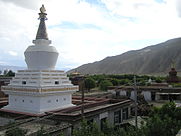| Translations of Stupa | |
|---|---|
| English | Stupa |
| Sanskrit | स्तूप |
| Pali | 𑀣𑀼𑀩𑁂 ("thube"), thūpa |
| Bengali | স্তূপ (st̪up) |
| Burmese | စေတီ (MLCTS: zèdì) |
| Chinese | 窣堵坡 (Pinyin: sūdǔpō) |
| Japanese | 卒塔婆 (Rōmaji: sotoba) |
| Khmer | ចេតិយ, ស្តូប (UNGEGN: chétĕy, stob) |
| Korean | 솔도파 (RR: soldopha) |
| Mongolian | суварга (suvarga) |
| Sinhala | දාගැබ් (dagab) |
| Tibetan | མཆོད་རྟེན་ (mchod rten (chorten)) |
| Tamil | தாது கோபுரம் |
| Thai | สถูป, เจดีย์ (RTGS: sa thup, chedi) |
| Vietnamese | Phù đồ, bảo tháp |
| Glossary of Buddhism | |
In Buddhism, a stupa (Sanskrit: स्तूप, lit. 'heap', IAST: stūpa) is a mound-like or hemispherical structure containing relics (such as śarīra – typically the remains of Buddhist monks or nuns) that is used as a place of meditation.[1]
Circumambulation, or pradakhshina, has been an important ritual and devotional practice in Buddhism since the earliest times, and stupas always have a pradakhshina path around them. The original South Asian form is a large solid dome above a tholobate, or drum, with vertical sides, which usually sits on a square base. There is no access to the inside of the structure. In large stupas, there may be walkways for circumambulation on top of the base as well as on the ground below it. Large stupas have, or had, vedikā railings outside the path around the base, often highly decorated with sculpture, especially at the torana gateways, of which there are usually four. At the top of the dome is a thin vertical element, with one or more horizontal discs spreading from it. These were chatras, symbolic umbrellas, and have not survived, if not restored. The Great Stupa at Sanchi, Madhya Pradesh, is the most famous and best-preserved early stupa in India.
Apart from very large stupas, designed to attract pilgrims, there were large numbers of smaller stupas in a whole range of sizes, which typically had much taller drums, relative to the height of the dome. Small votive stupas paid for by pilgrims might be less than a metre high, and laid out in rows by the hundred, as at Ratnagiri, Odisha, India.
As Buddhism spread, other forms were used for the same purposes, and the chortens of Tibetan Buddhism and pagodas of East Asian Buddhism are some of these. In Southeast Asia, various rather different elongated shapes of dome evolved, leading to high, thin spires. A related architectural term is a chaitya, which is a prayer hall or temple containing a stupa.
- ^ encyclopedia.com. Credited to James Stevens Curl, A Dictionary of Architecture and Landscape Architecture, 2000, originally published by Oxford University Press 2000.



